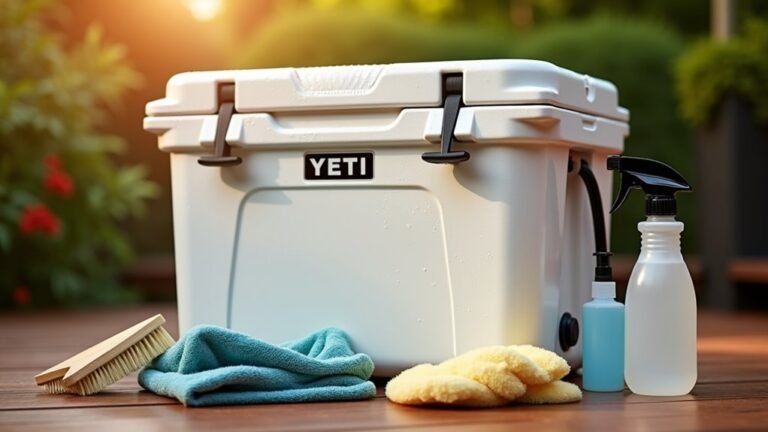A clogged bathtub drain can be more than just frustrating – it can cause serious problems like water damage and mold in your home if you don't fix it. While it might be tempting to pour chemical drain cleaners down the pipe, there are better and safer ways to solve the problem.
Some of the links in this article may be affiliate links. If you make a purchase through these links, we may earn a small commission at no extra cost to you. Thank you.
According to Bob Villa, a home improvement expert and television host, "Chemical drain cleaners can actually damage your pipes over time and should be avoided when possible. Instead, try natural solutions like baking soda and vinegar, which are just as effective and won't harm your plumbing."
The good news is that most bathtub clogs can be cleared using simple tools and methods that anyone can try at home. Whether it's hair, soap scum, or other buildup causing the problem, getting your drain flowing freely again doesn't have to be complicated or expensive.
Let's explore the best ways to fix a slow or clogged bathtub drain without calling a plumber or using harsh chemicals that could damage your pipes.
Drain Backing up Again?

When your bathtub drain starts backing up, it's usually a sign that hair, soap scum, or other debris has created an unwelcome clog in your plumbing.
We can help you tackle this common problem through several methods, from using white vinegar and baking soda treatments to checking the overflow cover.
If simple solutions don't work, it's time we consider calling a professional plumber for a thorough inspection.
##
Let's tackle the essential steps and precautions for cleaning your bathtub drain effectively.
We'll break down the process into what you should do, what you should avoid, and the specific steps needed to get your drain flowing smoothly again.
While cleaning a drain might seem straightforward, understanding the right techniques and potential pitfalls will help you maintain your plumbing without causing damage.
Things to Do When Cleaning a Bathtub Drain
Cleaning a bathtub drain requires a systematic approach to effectively remove blockages and maintain proper water flow.
Starting with a clear workspace by removing standing water allows better access to the drain, while inspecting and cleaning the overflow cover guarantees all potential clog points are addressed.
Using a combination of mechanical and chemical cleaning methods helps tackle different types of drain blockages effectively.
- Remove standing water – Clear the tub completely using a bucket or sponge to access the drain
- Remove and clean overflow plate – Unscrew the cover and clean out any accumulated debris
- Plunge the drain – Create a tight seal and plunge vigorously until water flows freely
- Use drain snake – Insert the tool to remove deep clogs that plunging couldn't clear
- Clear visible debris – Remove any visible hair or soap scum from the drain opening
- Apply cleaning solution – Pour baking soda followed by vinegar, wait 15 minutes, then flush with hot water
- Test water flow – Run water to verify proper drainage and repeat steps if necessary
- Regular maintenance – Clean monthly with baking soda and vinegar to prevent future clogs
Things to Avoid When Cleaning a Bathtub Drain
When cleaning a bathtub drain, it's crucial to approach the task with care and mindfulness to prevent damage to your plumbing system. While it may be tempting to use aggressive methods or harsh chemicals for quick results, these approaches can lead to costly repairs and long-term issues that could have been avoided with proper maintenance and cleaning techniques.
- Chemical drain cleaners – These harsh products can corrode pipes and damage protective finishes on plumbing fixtures.
- Excessive physical force – Aggressive plunging or forcing tools into the drain can crack or break pipes and fittings.
- Metal tools and scrapers – These can scratch and permanently damage the drain's surface and surrounding areas.
- Hot water beyond 140°F – Extremely hot water can soften PVC pipes and damage pipe joints.
- Multiple cleaning products simultaneously – Mixing different cleaning solutions can create dangerous chemical reactions.
- Ignoring regular maintenance – Waiting until a complete clog forms makes the problem more difficult to resolve.
- Flushing debris down drain – Pushing accumulated hair and soap scum further into the pipe can create bigger blockages.
- DIY chemical solutions – Homemade mixtures of cleaning products can be dangerous and damage plumbing.
Steps
Cleaning a bathtub drain effectively requires a systematic approach to guarantee thorough removal of debris and proper maintenance. A clogged drain can lead to standing water, unpleasant odors, and potential plumbing issues, making regular cleaning essential for maintaining proper drainage and hygiene in your bathroom.
Step 1: Remove all standing water from the tub using a bucket or sponge.
Step 2: Unscrew and remove the overflow cover plate.
Step 3: Insert a wet washcloth into the overflow opening to maintain pressure.
Step 4: Position the plunger over the drain and plunge vigorously until you hear gurgling.
Step 5: Remove the plunger and check if water drains properly.
Step 6: Use a drain snake or bent wire hanger to remove any remaining blockages.
Step 7: Extract all accumulated hair and debris from the drain.
Step 8: Flush the drain with hot water to guarantee proper flow.
Step 9: Reattach the overflow cover plate.
Step 10: Apply a monthly baking soda and vinegar treatment for maintenance.
Final Thoughts
Maintaining a clean and functional bathtub drain doesn't have to be an intimidating task if you're equipped with the right knowledge and tools.
With just a little bit of regular maintenance and preventive measures like mesh drain traps, we can avoid most serious clogs.
##

Regular drain maintenance is your best defense against stubborn clogs and expensive plumbing repairs.
Preventive drain care is a small investment that protects your plumbing system and helps avoid costly emergency repairs.
By incorporating simple habits like using drain traps and performing monthly natural cleaning treatments, you can keep your bathtub drain flowing smoothly.
When clogs do occur, remember to start with gentle physical methods like manual removal and plunging before considering more aggressive approaches.
Avoid harsh chemicals that can damage your plumbing system, and don't hesitate to call a professional if you encounter a particularly challenging blockage.
Take action today by installing a mesh drain trap and scheduling regular maintenance on your calendar.
A few minutes of preventive care each month can save you hours of frustration and costly repairs down the road.
Your bathtub drain will thank you with years of trouble-free service.






